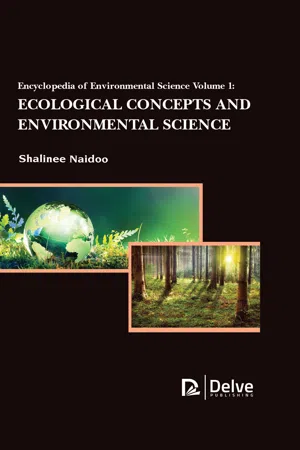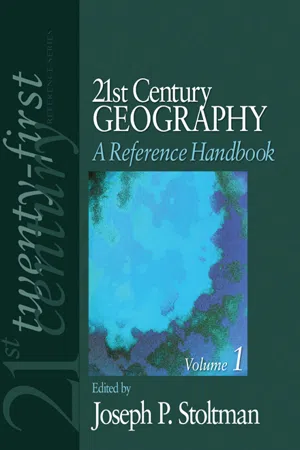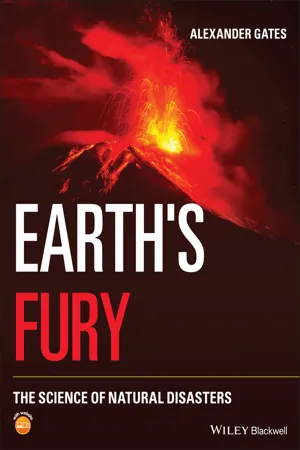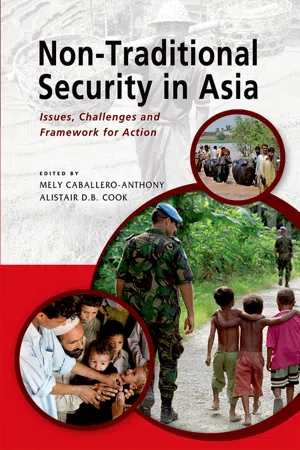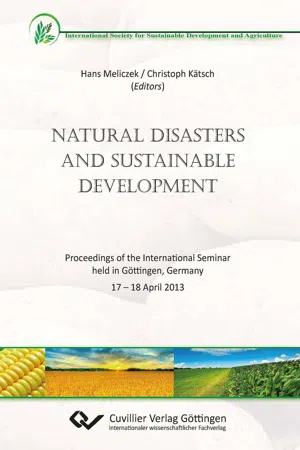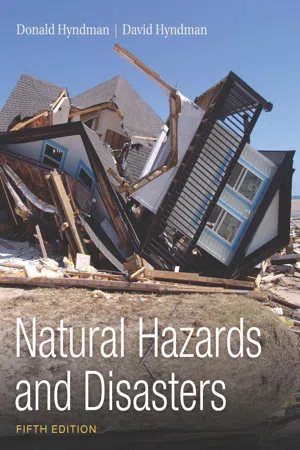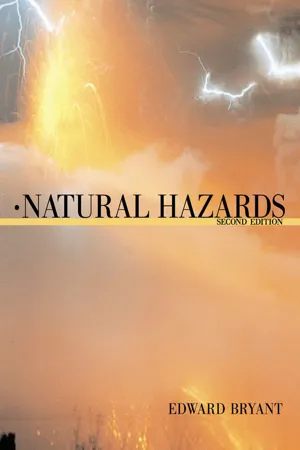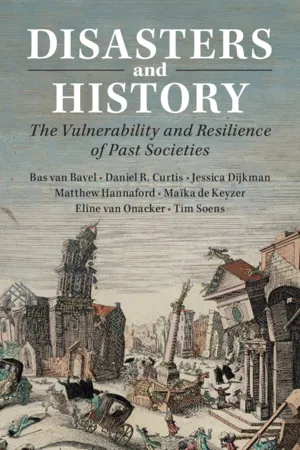Geography
Natural Disasters
Natural disasters are catastrophic events that occur due to natural processes of the Earth. These events can cause significant damage to the environment, infrastructure, and human life. Examples of natural disasters include earthquakes, hurricanes, floods, tsunamis, volcanic eruptions, and wildfires. Geographic factors such as location, topography, and climate play a crucial role in the occurrence and impact of natural disasters.
Written by Perlego with AI-assistance
Related key terms
1 of 5
11 Key excerpts on "Natural Disasters"
- eBook - PDF
Encyclopedia of Environmental Science Vol1
Ecological Concepts and Environmental Science
- Shalinee Naidoo(Author)
- 2019(Publication Date)
- Delve Publishing(Publisher)
The hazards usually relate to some kind of environmental process or system which include topographical, atmospheric, geochemical, edaphic or hydrological systems to name a few. Environmental disasters can be broken down into four main areas namely geohydrological, chemical, industrial and climatic disasters. Ecological Concepts and Environmental Science 60 8.1. Natural Disasters Natural Disasters are commonly defined as catastrophic events that occur as a result of nature or natural processes of the Earth. Natural processes such as weather patterns and energy flows, for example, in turn, affect vulnerable populations and surrounding environments leading to extensive damage and loss (Davis et al., 2010). These types of disasters include floods, earthquakes, hurricanes, tornadoes, tsunamis, mudslides, volcanic eruptions sinkholes, droughts and other related geological processes. The area in which these phenomenon occurs will determine if they are classified as a disaster or not. Those events that occur in unpopulated areas are not considered disasters so for example, a flood on a deserted island or a volcanic eruption in an unpopulated city would not be considered disasters. Natural Disasters always cause some kind of loss in some way. Depending on the brutality of the natural disaster, loss of life, property damage and a great deal of environmental damage and economic loss can occur. The severity of the disaster is often measured in the number of lives lost, economic loss as well as the resilience of the surrounding environment and ability of the affected populations to recover and rebuild. Collapsing buildings, disruption of transport and societal livelihoods are often results from Natural Disasters which take a tremendous amount of time to recover from. In addition, personal effects are often great due to the loss of possessions and memorabilia of those affected. - eBook - PDF
- Joseph P. Stoltman(Author)
- 2011(Publication Date)
- SAGE Publications, Inc(Publisher)
Hurricane Katrina made landfall near New Orleans, Louisiana, and on the Gulf Coast of the United States; Mount Tungurahua in Ecuador 509 510 • NATURE AND SOCIETY has erupted on many occasions since 1999; and the Yangtze River and others have flooded large areas of southern China in 2010. These events culminated in Natural Disasters. A natural disaster, then, is associated with the loss of life and/ or the destruction of property; it results in the disruption of societal activities. Having said this, there is no agreed upon threshold with respect to how much destruction, economic loss, or number of deaths are required to define an event as a disaster in large part because it matters where the event occurs. One could hardly argue that the 1998 flooding in Bangladesh along the Brahmaputra, Ganges, and Meghna Rivers in which some 300,000 houses were destroyed and 1,000 people were killed was not a disaster. Yet as will be seen throughout this chapter, context matters. An event that has little or no loss of life but that cuts off transportation routes and causes disruptions to business activity and industrial production can have severe economic impacts that could be considered a disaster. The essence of disas- ters, therefore, is the interaction of human society with the geophysical environment; it is the relationship between societal activities and geophysical processes that deter- mines the extent and intensity of a natural disaster. Thus, many geographers have questioned the term natural disas- ter because it is the human element that defines whether or not an event becomes a disaster. Missing from these definitions of hazard and disaster is the role played by population trends. The population of the world has grown significantly, increasing from 1.6 billion in 1900 to an estimated 7 billion in 2011, and therefore basic measures of losses and deaths will undoubtedly reflect some of this population increase. - eBook - PDF
Earth's Fury
The Science of Natural Disasters
- Alexander Gates(Author)
- 2022(Publication Date)
- Wiley-Blackwell(Publisher)
1 CHAPTER 1 Earth’s Fury: The Science of Natural Disasters, First Edition. Alexander Gates. © 2022 John Wiley & Sons Ltd. Published 2022 by John Wiley & Sons Ltd. Companion website: www.wiley.com/go/gates/earthsfury Introduction to Natural Disasters CHAPTER OUTLINE 1.1 What Is a Natural Disaster? 3 1.2 Why Do People Live in Dangerous Areas? 5 1.3 What Can We Do to Stay Safe? 8 1.4 Societal Response to Natural Disasters 9 1.5 How This Book Is Organized 14 What Is a Natural Disaster? 3 Words You Should Know: Earthquake – An event in which the breakage of rock along a fault within the earth causes the release of energy in the form of seismic waves. Disaster reduction engineering – Construction practices that are designed to reduce the impact of a natural disaster. Hurricane – A highly energetic, individual tropical storm that develops over warm ocean waters. Natural disaster – A natural event that causes loss of life or property, either directly or indirectly, as a result of the aftermath. Population growth – The increase in human population over time. Tsunami – Meaning “harbor wave” in Japanese, a tsunami is an energetic ocean wave generated by a physical event (earth- quake, volcano, landslide) on the earth’s surface. Volcano – The geographic feature resulting from the release of lava and/or solid ejecta from a vent in the earth. 1.1 What Is a Natural Disaster? Humans seek to protect their lives at all costs. Major efforts and enormous amounts of money are devoted to medications and medical procedures that can increase human life by even a short amount of time. These efforts have increased the average life span worldwide and protected people from many natural threats. This increased protection has led to a sense of security among many of not having to worry about the threats, especially in the developed world. - eBook - PDF
Non-Traditional Security in Asia
Issues, Challenges and Framework for Action
- Mely Caballero-Anthony, Alistair D.B. Cook(Authors)
- 2013(Publication Date)
- ISEAS Publishing(Publisher)
85 5 Natural Disasters Mely Caballero-Anthony, Irene A. Kuntjoro, Sofiah Jamil, Pau Khan Khup Hangzo and Sadhavi Sharma Southeast Asia witnesses a number of Natural Disasters and did so through-out 2010, highlighting variable levels of national preparedness in dealing with disasters and illustrating the need for greater regional cooperation. This chapter looks at how governments in this disaster-prone region respond to the impact of these large scale events. What are Natural Disasters? The Centre for Research on the Epidemiology of Disasters (CRED) defines a disaster as “a situation or event which overwhelms local capacity, necessitating a request to a national or international level for external assistance; an unforeseen and often sudden event that causes great damage, destruction and human suffering”. 1 For a disaster to be entered into its Emergency Events Database or EM-DAT, at least one of the following criteria must be fulfilled: 10 or more people reported killed; 100 or more people reported affected; declaration of a state of emergency; and calls for international assistance. The EM-DAT distinguishes two generic categories for disasters: natural and technological. The natural disaster category was further divided into five sub-groups, which in turn cover twelve disaster types and more than thirty sub-types, as can be found on Table 5.1. As in previous years, in 2008 Asia remained the most affected continent by Natural Disasters. The region accounted for 40 per cent of all reported Natural Disasters and more than 80 per cent of all reported victims. Economic 86 Non-Traditional Security in Asia table 5.1 Classification of Natural Disasters Disaster Sub-Group Definition Disasters: Main Types Geophysical Events originating from solid earth. - eBook - PDF
Natural Disasters and Sustainable Development
Proceedings of the International Seminar held in Göttingen, Germany 17 – 18 April 2013
- (Author)
- 2014(Publication Date)
- Cuvillier Verlag(Publisher)
3 Natural Disasters and Sustainable Development, an Overview Hans Meliczek Chairman of the International Society for Sustainable Development and Agriculture, Göttingen, [email protected] , [email protected] Introduction Over the last 60 years the world has experienced a dramatic increase in the number of Natural Disasters such as floods, hurricanes, earthquakes, volcanic eruptions and tsunamis. Disasters constitute a serious impediment to sustainable development and are frequently a major cause for slow social and economic progress. The concern about the destructive effects of Natural Disasters on the lives and livelihoods of individuals and communities has been on the agenda of the international community since the UN Conference on Disaster Risk Reduction held in Yokohama in 1994 (UN, 1994). The progress achieved in international efforts for disaster risk reduction was subsequently debated at the World Conference on Disaster Reduction, held in Kobe, Hyogo Prefecture, Japan in January 2005. The conference adopted the Hyogo Framework of Action which em-phasizes a shift from reactive emergency relief to pro-active disaster risk reduction. It recog-nized that disaster loss was on the rise with grave consequences for the survival, dignity and livelihood of individuals and adopted a Framework of Action to promote a strategic and sys-tematic approach to reduce vulnerabilities and risks to hazards (UNISDR, 2005). Natural Disasters are the result of the combination of hazard, vulnerability and insuffi-cient capacity to reduce the potential chances of risk. A disaster happens when a hazard im-pairs vulnerable populations and causes damage and casualties. An earthquake, for instance, in an unpopulated desert is not considered a disaster. It is disastrous only when it affects people, their properties and activities. Vulnerability factors are environmental degradation, inappropriate locations, unsafe buildings and lack of institutions and inadequate education. - No longer available |Learn more
- Donald Hyndman, David Hyndman(Authors)
- 2016(Publication Date)
- Cengage Learning EMEA(Publisher)
The fisherman enjoying a quiet afternoon trout fishing in a small stream can hardly imagine how a 100-year flood might transform the scene. Someone gazing at a serene, snow-covered mountain can hardly imagine it erupting in an explosive blast of hot ash followed by destructive mudflows racing down its flanks. Large or even gigantic events are a part of nature. Such abrupt events produce large results that can be disastrous if they affect people. Human Impact of Natural Disasters When a natural process poses a threat to human life or prop- erty, we call it a natural hazard. Many geologic processes are potentially hazardous. For example, streams flood as part of their natural process and become a hazard to those liv- ing nearby. A hazard is a natural disaster when the event causes significant damage to life or property. A moderate flood that spills over a floodplain every few years does not often wreak havoc, but when a major flood strikes, it may lead to a disaster that kills or displaces many people. When a natural event kills or injures large numbers of people or causes extensive property damage, it is called a catastrophe. The potential impact of a natural disaster is related not only to the size of the event but also to its effect on the pub- lic. A natural event in a thinly populated area can hardly pose a major hazard. For example, the magnitude 7.6 earth- quake that struck the southwest corner of New Zealand on July 15, 2009, was severe but posed little threat because it happened in a region with few people or buildings. In con- trast, the much smaller January 12, 2010, magnitude 7.0 earthquake in Haiti killed more than 46,000 (FIGURE 1-2). In another example, the eruption of Mt. St. Helens in 1980 FIGURE 1-2 A Disaster Takes a High Toll Searchers dig for survivors of the Haiti earthquake of January 12, 2010, which killed more than 316,000, mostly in concrete and cinder block buildings with little or no reinforcing steel. - eBook - PDF
- Edward Bryant(Author)
- 2005(Publication Date)
- Cambridge University Press(Publisher)
This book deals mainly with episodic hazards, events that wreak havoc upon humans. However, the message is not one of total doom and gloom. Humans choose hazardous areas because they often offer benefits. For example, ash from volcanoes produces rich soils that can grow three crops per year in the tropics, and floodplains provide easily cultivated agricultural land close to a water supply. Humans in these environments are forced to predict and avoid natural calamities such as landslides, cyclones, earthquakes, and drought. Or as Middleton (1995) states, ‘a hazard should be seen as an occasion-ally disadvantageous aspect of a phenomenon, which is often beneficial to human activity over a different timescale.’ For those hazards that cannot be avoided by humans, this book also examines how people can minimize their effects and rectify their negative consequences. The book is organized around climatic and geologi-cal hazards. Intense storms and winds, oceanographic factors such as waves, ice and sea level changes, together with extreme precipitation phenomena, are all investigated under the heading of climatic hazards. Earthquakes, volcanoes, and land instability are examined under the topic of geological hazards. This book is not concerned overly with biological hazards such as plague, disease, and insect infestations; but one Introduction to Natural Hazards C H A P T E R 1 should realize that death and property loss from these latter perils can be just as severe as, if not worse than, those generated by geological and climatic hazards. A final section examines the social impact of hazards. HISTORICAL BACKGROUND The world of myths and legends (Holmes, 1965; Day, 1984; Myles, 1985; Milne, 1986; Bryant, 2001) Myths are traditional stories focusing on the deeds of gods or heroes, often to explain some natural phenom-enon, while legends refer to some historical event handed down – usually by word of mouth in traditional societies. - eBook - PDF
Geomorphology and Natural Hazards
Proceedings of the 25th Binghamton Symposium in Geomorphology, Held September 24-25, 1994 at SUNY, Binghamton, USA
- M. Morisawa(Author)
- 2013(Publication Date)
- Elsevier Science(Publisher)
0169-555X/94/$07.00 © 1994 Elsevier Science B.V. All rights reserved SSD/0169-555X(94)00029-Q «MM 28 C.L. Rosenfeld/Geomorphology 10 (1994) 27-36 120 Earthquake H Flood M Windstorm Others Number of Natural Disasters 65 70 75 80 85 90 Casualties Fig. 1. Annual total of fatal hazard events with deaths and missing persons directly attributed to Natural Disasters, 1960-1992 (after Berz, 1992). Another perplexing question centers upon the appar-ent increase in frequency of Natural Disasters. Accurate statistical analyses of such infrequent occurrences requires an observation period well in excess of a cen-tury (Berz, 1993), while the consistent reporting of most disaster types has a much shorter history. Moni-toring techniques, measurement scales (e.g. Richter, Beaufort), and communications have only recently allowed the global reporting of events in comparable terms. A study of volcanic eruptions by Simpkin et al. (1981) concludes that the reported increase in volcanic activity over the past 120 years is almost certainly due to improved reporting and communications technol-ogy; they even cite a reduction in apparent activity during the two world wars. Fig. 1 (after Berz, 1993) shows the trends of earthquakes, floods, windstorms and other casualty producing natural events since 1960. Despite the growing influence of global databases, sci-entific consortia and the news media, additional factors may be influencing the growing number of reported disasters. While considerable scientific debate lingers around the issue of global climatic change, geomorphologists are well aware of other indirect effects of human activ-ity. Certainly the deforestation of large areas has caused landslides (Swanson and Dyrness, 1975) and increased both the frequency and peak flows of flood events in many areas (Kaith, 1960; Harrold, 1971; Kahn and Nazem, 1988), while over-grazing has accel-erated drought effects and erosion (Berry, 1984). - Lucy A. Arendt, Daniel J Alesch(Authors)
- 2014(Publication Date)
- CRC Press(Publisher)
As Homo sapiens became cognizant of inexplicable phenomena many centuries ago, it was entirely reasonable for them to attribute vol-canic eruptions, hurricanes, and earthquakes to supernatural forces and to seek ways to appease those forces with ritual and sacrifice. Some of the natural events were seen as useful and desirable. The annual flooding of 32 Long-Term Community Recovery from Natural Disasters the Nile River was generally beneficial. From time to time, however, the annual spring flood failed to materialize, leading to poor harvests and sometimes famine. Other times, the spring flooding was much greater than anticipated and caused damage, dislocation, and, again, scanty harvests and famine. Other events were far less beneficial to human set-tlements: massive storms, volcanic eruptions, and earthquakes certainly must have terrified people at a time when few, if any, observers under-stood what they were, how they came about, and had scant warning when they occurred. Some kinds of those completely natural events came to be defined as natural hazard events because they frequently had adverse effects on people’s settlements, their social and economic pursuits, and features of the natural environment important to them. Many people apparently still believe that supernatural phenomena may account for natural haz-ard events, but, beginning about 100 years ago, others began to subscribe to the belief that the Earth’s dynamics were responsible for hurricanes, volcanic eruptions, floods, earthquakes, tornadoes, rivers overflowing their banks from time to time, and the like. Our collective understanding of the roles of tectonic plates, solar heating of the land and water, the Earth’s rotation, and the Earth’s core in generating natural phenomena on and near the Earth’s surface is very recent; plate tectonics did not gain a solid foothold until the 1960s. Entirely natural events have been occurring since Earth was formed.- eBook - PDF
Global Trends
Facing up to a Changing World
- A. Done(Author)
- 2011(Publication Date)
- Palgrave Macmillan(Publisher)
The UN Secretary General Ban Ki-moon noted that it was the worst disaster he had ever seen. An indication that most of these 20 million-plus affected were poor is that the estimated economic damage was put at a com- paratively low $ 9.5 billion. Beyond the dollar values though, the human sor- row was considerable: We never thought the waters would rise so high. I was away at my aunt’s house… My relatives said to wait until the tide ebbs, but it kept rising, and soon it was clear that my part of the city had drowned. My mother died… She was washed away. We haven’t found her body. My brother is traumatized. 7 People are suffering with diarrhoea and nausea. I’m a doctor and I’m trying to help but have no transport or medicine. I’m sitting in front of a preg- nant lady who needs medical assistance and there are no roads to take her to hospital… We don’t have medicine. People are sick and I can’t test to see whether it’s a cholera outbreak. There is no electricity, no drinking water. 8 The EM-DAT International Disaster Database classifies Natural Disasters into five categories. Geophysical disasters include events originating from solid earth such as earthquakes and volcanoes. Meteorological disasters are caused by short-lived (from minutes to days), small- to medium-scale atmospheric processes such as storms. Hydrological disasters, such as flooding or wet-earth movements (for example mudslides), result from deviations in the normal water cycle or overflows of bodies of water. Climatological disasters such as drought, extreme temperatures, and wildfire are caused by long-lived (from intra-seasonal to multi-decadal climate variability), medium- to large-scale atmospheric processes. The last EM-DAT category is Biological disasters such as epidemics and insect infestations. 9 - eBook - PDF
Disasters and History
The Vulnerability and Resilience of Past Societies
- Bas van Bavel, Daniel R. Curtis, Jessica Dijkman, Matthew Hannaford, Maïka de Keyzer, Eline van Onacker, Tim Soens(Authors)
- 2020(Publication Date)
- Cambridge University Press(Publisher)
29 Gilbert White’s ground-breaking work on floodplain management famously stated: “Floods are an act of God, but flood losses are largely an act of man.” 30 Still, these early roots of disaster studies created a field that was mainly interested in the aftermath of disaster and focused on practical knowledge for disaster management. Disasters were seen as an event – as a short rupture of normalcy. In the 1990s, this was famously challenged by the work of Wisner and Blaikie, whose ‘At Risk’ argued that “although events such as hurricanes, floods, and earthquakes serve as triggers for disasters, disasters themselves originate in social conditions and processes that may be far removed from events themselves.” 31 Anthropologists also devel- oped a keen interest in disasters, often focusing on the bottom-up disaster experience of the ‘subaltern,’ adding new class, gender, and race perspec- tives to a field that had long been dominated by affluent white men. 32 These developments heavily nuanced the long-standing belief in the naturalness of disasters and the emphasis on the effects of disasters that had long dominated the field. As climate change rose in importance on the political agenda, disaster studies increasingly concerned itself with anthropogenic climate change using the established concepts of vulnerability, resilience, and adaptation. 33 The UN call for the International Decade for Natural Disaster Reduction (IDNDR) during the 1990s and early 2000s played a part in this. Also very decisive was the 2004 ‘Reducing Disaster Risk’ report by the UNDP. As climate change disproportionally impacted the developing world, the need for resilience and adaptation took center stage. This led to an increased interest in these topics in the social sciences, which trickled down to the field of history – albeit slowly.
Index pages curate the most relevant extracts from our library of academic textbooks. They’ve been created using an in-house natural language model (NLM), each adding context and meaning to key research topics.
